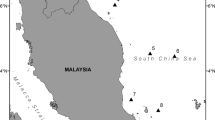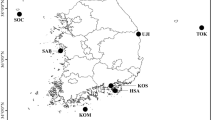Abstract
The crimson jobfish, Pristipomoides filamentosus Valenciennes, 1830 is an economically important demersal species largely distributed in the Indo-Pacific region. Pristipomoides filamentosus constitutes a significant portion of catch landed in demersal fisheries throughout the species’ distribution range. Despite the species’ economic importance, there is insufficient data to guide the species’ conservation management, especially within the south-western (SW) Indian Ocean region. The aims of the present study were to conduct a population genetic analysis to determine the spatial genetic structure of the species and, whether different management units could be established in the region, using an analysis of both mitochondrial DNA fragment (mtDNA), and nuclear microsatellite loci. A total of 193 fin clips were collected from Seychelles, Kenya, Tanzania, Comoros, Madagascar, Mauritius and South Africa, with each having an established fishery of the species. Both haplotype diversity (h) and expected heterozygosity (HE) for mtDNA and microsatellite loci respectively were generally high for all localities, except for Seychelles where both diversity indices were at the lowest (i.e. h = 0.429 ± 0.134; HE = 0.647 ± 0.059). Even though mtDNA failed to detect population differentiation, the hypervariable microsatellite loci consistently indicated presence of four genetic clusters irrespective of the clustering approach applied. Based on present results, we propose recognising the four clusters as distinct fisheries management units of the species in the SW Indian Ocean region.




Similar content being viewed by others
References
Muths D, Tessier E, Bourjea J (2015) Genetic structure of the reef grouper Epinephelus merra in the West Indian Ocean appears congruent with biogeographic and oceanographic boundaries. Mar Ecol 36:447–461
Newman SJ, Williams AJ, Wakefield CB et al (2016) Review of the life history characteristics, ecology and fisheries for deep-water tropical demersal fish in the Indo-Pacific region. Rev Fish Biol Fish 26:537–562
Leis JM, Lee K (1994) Larval development in the lutjanid subfamily Etelinae (Pisces): the genera Aphareus, Aprion, Etelis and Pristipomoides. Bull Mar Sci 55:46–125
Moffitt RB, Parrish FA (1996) Habitat and life history of juvenile Hawaiian pink snapper, Pristipomoides filamentosus. Pac Sci 50:370–381
Gaither MR, Jones SA, Kelley C, Newman SJ, Sorenson L, Bowen BW (2011) High Connectivity in the Deepwater Snapper Pristipomoides filamentosus (Lutjanidae) across the Indo-Pacific with Isolation of the Hawaiian Archipelago. PLoS ONE 6(12):e28913. https://doi.org/10.1371/journal.pone.0028913
Palumbi S (1994) Genetic divergence, reproductive isolation and marine speciation. Annu Rev Ecol Syst 25:547–572
Ragionieri L, Cannicci S, Schubart C, Fratini S (2010) Gene flow and demographic history of the mangrove crab Neosarmatium meinerti: a case study from the western Indian Ocean. Estuar Coast Shelf Sci 86:179–188
Silva IC, Mesquita N, Paula J (2010) Lack of population structure in the Fiddler crab Uca annulipes along an East African latitudinal gradient: genetic and morphometric evidence. Mar Biol 157:1113–1126
Visram S, Yang MC, Pillay RM, Said S, Henriksson O, Grahn M et al (2010) Genetic connectivity and historical demography of the blue barred parrotfish Scarus ghobban in the western Indian Ocean. Mar Biol 157:1475–1487
Mkare TK, von der Heyden S, Groeneveld JC, Matthee CA (2014) Genetic population structure and recruitment patterns of three sympatric shallow-water penaeid prawns in Ungwana Bay, Kenya, with implication for fisheries management. Mar Freshw Res 65:255–266
Mkare TK, Groeneveld JC, Teske PR, Matthee CA (2017) Comparative genetic structure in two high-dispersal prawn species from the south-west Indian Ocean. Afr J Mar Sci 39:467–474
Otwoma LM, Kochzius M (2016) Genetic population structure of the coral reef sea star Linckia laevigata in the Western Indian Ocean and Indo-West Pacific. PLoS ONE 11:e0165552. https://doi.org/10.1371/journal.pone.0165552
Groeneveld JC, Von der Heyden S, Matthee CA (2012) High connectivity and lack of mtDNA differentiation among two previously recognized spiny lobster species in the southern Atlantic and Indian Oceans. Mar Biol Res 8:764–770
Sá-Pinto A, Branco MS, Alexandrino PB, Fontaine MC, Baird SJE (2012) Barriers to gene flow in the marine environment: insights from two common intertidal limpet species of the Atlantic and Mediterranean. PLoS ONE 7(12):e50330
Silva CNS, Gardner JPA (2016) Identifying environmental factors associated with the genetic structure of the New Zealand scallop: linking seascape genetics and ecophysiological tolerance. ICES J Mar Sci 73:1925–1934
Anderson WD, Allen GR (2001) Lutjanidae. Jobfishes. Food and Agricultural Organization, Rome
Allen GR, Talbot FH (1985) Review of the snappers of the genus Lutjanus (Pisces, Lutjanidae) from the Indo-Pacific, with description of a new species. Indo-Pacific Fishes 11:1–87
Allen GR (1985) FAO species catalogue. Snappers of the world. An annotated and illustrated catalogue of lutjanid species known to date. FAO, Rome, Italy
Martell SJD, Kroman J, Darcy M, Christensen LB, Zeller D (2006) Status and trends of the Hawaiian bottom fish stocks: 1948–2004. University of British Columbia Fisheries Centre, Vancouver
Van der Elst RP, Everett BI (2015) (eds). Offshore fisheries of the Southwest Indian Ocean: their status and the impact on vulnerable species. Oceanographic Research Institute, Special Publication 10
Andrews AH, DeMartini EE, Brodziak J, Nicholas RS, Humphreys RL (2012) A long lived life history for a tropical, deep water snapper (Pristipomoides filamentosus): bomb radiocarbon and lead-radium dating as extensions of daily increment analysis in otoliths. J Fish Aquat Sci 69:1850–1869
Grimes C (1987) Reproductive biology of Lutjanidae. In: Polovina JJ, Ralston S (eds) Review paper in Tropical snappers and groupers: biology and fisheries management. Westview Press, Boulder, pp 239–294
Brodziak J, Courtney D, Wagatsuma L, O’Malley J, Lee H, Walsh W et al (2011) Stock Assessment of the Main Hawaiian Islands Deep 7 bottom fish complex through 2010. U.S. Dept. Commerce, NOAA Technical Memorandum, NOAA-TM-NMFS-PIFSC-29
Haight WR, Kobayashi DR, Kawamoto K (1993) Biology and management of deepwater snappers of the Hawaiin Archipelago. Mar Fish Res 55:20–27
Meyer A (1994) Shortcomings of the cytochrome b gene as a molecular marker. Trends Ecol Evol 9:278–280
Taberlet P, Meyer A, Bouvet J (1992) Unusual mitochondrial DNA polymorphism in two local populations of blue tit, Parus caeruleus. Mol Ecol 1:27–36
Gaither MR, Toonen RJ, Robertson DR, Planes S, Bowen BW (2010) Genetic evaluation of marine biogeographical barriers: perspectives from two widespread Indo-Pacific snappers (Lutjanus kasmira and Lutjanus fulvus). J Biogeogr 37:133–147
Thompson JD, Higgins DG, Gibson TJ (1994) CLUSTALW: improving the sensitivity of progressive multiple sequence alignment through sequence weighting, position-specific gap penalties and weight matrix choice. Nucleic Acids Res 22:4673–4680
Kumar S, Stecher G, Tamura K (2016) MEGA7: molecular evolutionary genetics analysis version 7.0 for bigger datasets. Mol Biol Evol 33:1870–1874
Villesen P (2007) FaBox: an online toolbox for fasta sequences. Mol Ecol Notes 7:965–968
Excoffier L, Lischer HEL (2010) Arlequin suite ver 3.5: a new series of programs to perform population genetics analyses under Linux and Windows. Mol Ecol Res 10:564–567
Leigh JW, Bryant D (2015) pop-art: full-feature software for haplotype network construction. Methods Ecol Evol 6:1110–1116
Van Oosterhout C, Hutchinson WF, Wills DPM, Shipley P (2004) MICRO-CHECKER: software for identifying and correcting genotyping errors in microsatellite data. Mol Ecol Notes 4:535–538
Van Oosterhout C, Weetman D, Hutchinson WF (2006) Estimation and adjustment of microsatellite null alleles in nonequilibrium populations. Mol Ecol Notes 6:255–256
Rice WR (1989) Analyzing tables of statistical tests. Evolution 43:223–225
Raymond M, Rousset F (1995) An exact test for population differentiation. Evolution 49:1280–1283
Rousset F (2008) Genepop’007: a complete reimplementation of the Genepop software for Windows and Linux. Mol Ecol Resour 8:103–106
Belkhir K, Borsa P, Chikhi L, Raufaste N, Bonhomme F (2004) GENETIX 4.05, Population genetics software for Windows™. Université de Montpellier II, Montpellier
Park SDE (2001) The Excel microsatellite toolkit (version 3.1). Animal Genomics Laboratory, University College, Dublin
Nei M (1987) Molecular evolutionary genetics. Columbia University Press, New York
Kalinowski ST (2004) Counting alleles with rarefaction: private alleles and hierarchical sampling designs. Conserv Genet 2:539–543
Kalinowski ST (2005) HP-RARE 1.0: a computer program for performing rarefaction on measures of allelic richness. Mol Ecol Notes 5:187–189
Meirmans PG, Hedrick PW (2011) Assessing population structures: FST and related measures. Mol Ecol Resour 11:5–18
Peakall R, Smouse PE (2012) GenAlEx 6.5: genetic analysis in Excel. Population genetic software for teaching and research-an update. Bioinformatics 28:2537–2539
Jombart T, Devillard S, Balloux F (2010) Discriminant analysis of principal components: a new method for the analysis of genetically structured populations. BMC Genet 11(1):94
Jombart T, Devillard S, Dufour AB, Pontier D (2008) Revealing cryptic spatial patterns in genetic variability by a new multivariate method. Heredity 101:92–103
Pritchard JK, Stephens M, Donnelly P (2000) Inference of population structure using multilocus genotype data. Genetics 155:945–959
Hubisz MJ, Falush D, Stephens M, Pritchard JK (2009) Inferring weak population structure with the assistance of sample group information. Mol Ecol Res 9:1322–1332
Evanno G, Regnaut S, Goudet J (2005) Detecting the number of clusters of individuals using the software STRUCTURE: a simulation study. Mol Ecol 4:2611–2620
Earl DA, von Holdt BM (2012) STRUCTURE HARVESTER: a website and program for visualizing STRUCTURE output and implementing the Evanno method. Conserv Genet Resour 4:359–361
Jakobsson M, Rosenberg NA (2007) CLUMPP: a cluster matching and permutation program for dealing with label switching and multimodality in analysis of population structure. Bioinformatics 23:1801–1806
Rosenberg NA (2004) DISTRUCT: a program for the graphical display of population structure. Mol Ecol 4:137–138
Corander J, Walmann P, Sillanpaa MJ (2003) Bayesian analysis of genetic differentiation between populations. Genetics 163:367–374
Putman AI, Carbone I (2014) Challenges in analysis and interpretation of microsatellite data for population genetic studies. Ecol Evol 22:4399–4428
Leffler EM, Bullaughey K, Matute DR, Meyer WK, Ségurel L et al (2012) Revisiting an old riddle: what determines genetic diversity levels within species? PLoS Biol 10(9):e1001388. https://doi.org/10.1371/journal.pbio.1001388
Keller LF, Waller DM (2002) Inbreeding effects in wild populations. Trends Ecol Evol 17:230–241
You EM, Chiu TS, Liu KF, Tassanakajon A, Klinbunga S, Triwitayakorn K, Pena LD, Li Y, Yu HT (2008) Microsatellite and mitochondrial haplotype diversity reveals population differentiation in the tiger shrimp (Penaeus monodon) in the Indo-Pacific region. Anim Genet 39:267–277
Otwoma LM, Reuter H, Timm J, Meyer A (2018) Genetic connectivity in a herbivorous coral reef fish (Acanthurus leucosternon Bennet, 1833) in the Eastern African region. Hydrobiologia 806:237–250
Wright S (1943) Isolation by distance. Genetics 28:114–138
Young EF, Belchier M, Hauser L, Horsburgh GJ, Meredith MP, Murphy EJ et al (2015) Oceanography and life history predict contrasting genetic population structure in two Antarctic fish species. Evol Appl 8:486–505
Wright D, Bishop JM, Matthee CA, von der Heyden S (2015) Genetic isolation by distance reveals restricted dispersal across a range of life histories: implications for biodiversity conservation planning across highly variable marine environments. Divers Distrib 21:698–710
Acknowledgements
The authors are grateful to all people involved in the collection of tissue samples of the species in the seven countries. The entire management of the concluded South West Indian Ocean Fisheries Project (SWIOFP) are appreciated for logistical support and for awarding an MSc grant to FAM. We also thank BecA-ILRI Hub for providing laboratory space. The project was fully funded by the South West Indian Ocean Fisheries Project (SWIOFP).
Author information
Authors and Affiliations
Corresponding author
Ethics declarations
Conflict of interest
Funding was provided to FAM through South West Indian Ocean Fisheries Project (SWIOFP) and the authors have no conflict of interest.
Ethical approval
All applicable national and institutional guidelines for the use of animal tissues were applied.
Additional information
Publisher's Note
Springer Nature remains neutral with regard to jurisdictional claims in published maps and institutional affiliations.
Electronic supplementary material
Below is the link to the electronic supplementary material.
Rights and permissions
About this article
Cite this article
Mzingirwa, F.A., Mkare, T.K., Nyingi, D.W. et al. Genetic diversity and spatial population structure of a deepwater snapper, Pristipomoides filamentosus in the south-west Indian Ocean. Mol Biol Rep 46, 5079–5088 (2019). https://doi.org/10.1007/s11033-019-04962-w
Received:
Accepted:
Published:
Issue Date:
DOI: https://doi.org/10.1007/s11033-019-04962-w




